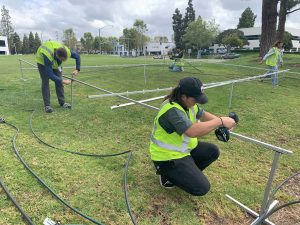Rainfall generator built to support ongoing turf replacement BMP study

SCCWRP has designed and custom-built a second rainfall generator that will support an ongoing study measuring how much rainfall soaks into the ground vs. runs off the land at sites with drip irrigation and drought-tolerant landscaping.
The new instrument, developed over the past few months and initially tested in April, will enable researchers to simulate relevant, controlled rainfall patterns at sites where spray-irrigated turf has been replaced with drip irrigation systems. Unlike SCCWRP’s original rainfall generator, which was developed in 2023 for water-quality studies, the new rainfall generator is designed to produce multiple rainfall intensities that are relevant for studying runoff hydrology.
Stormwater managers want to know the ratio of water that soaks into the ground vs. runs off the land at turf replacement sites – known as the runoff coefficient – so they can model how much rainfall and irrigation is expected to be retained. Although managers typically take this information from reference textbooks and practitioner manuals, there are no published values for turf replacement sites because it is a novel land-use type that doubles as a non-structural BMP.
Researchers are using the rainfall generator, affectionately known as the Soaker 2.0, to quantify runoff coefficients from three land-use types (turf replacement BMPs, conventional turf, and asphalt) so they can quantify the relative water savings and runoff volumes from each land-use type.
More news related to: Runoff Water Quality, Stormwater BMPs